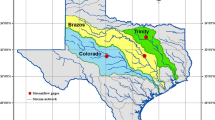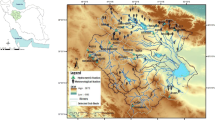Abstract
Low flow forecasting is crucial for sustainable cooling water supply and planning of river navigation in the Rhine River. The first step in reliable low flow forecasting is to understand the characteristics of low flow. In this study, several methods are applied to understand the low flow characteristics of Rhine River basin. In 108 catchments of the Rhine River, winter and summer low flow regions are determined with the seasonality ratio (SR) index. To understand whether different numbers of processes are acting in generating different low flow regimes in seven major sub-basins (namely, East Alpine, West Alpine, Middle Rhine, Neckar, Main, Mosel and Lower Rhine) aggregated from the 108 catchments, the dominant variable concept is adopted from chaos theory. The number of dominant processes within the seven major sub-basins is determined with the correlation dimension analysis. Results of the correlation dimension analysis show that the minimum and maximum required number of variables to represent the low flow dynamics of the seven major sub-basins, except the Middle Rhine and Mosel, is 4 and 9, respectively. For the Mosel and Middle Rhine, the required minimum number of variables is 2 and 6, and the maximum number of variables is 5 and 13, respectively. These results show that the low flow processes of the major sub-basins of the Rhine could be considered as non-stochastic or chaotic processes. To confirm this conclusion, the rescaled range analysis is applied to verify persistency (i.e. non-randomness) in the processes. The estimated rescaled range statistics (i.e. Hurst exponents) are all above 0.5, indicating that persistent long-term memory characteristics exist in the runoff processes. Finally, the mean values of SR indices are compared with the nonlinear analyses results to find significant relationships. The results show that the minimum and maximum numbers of required variables (i.e. processes) to model the dynamic characteristics for five out of the seven major sub-basins are the same, but the observed low flow regimes are different (winter low flow regime and summer low flow regime). These results support the conclusion that a few interrelated nonlinear variables could yield completely different behaviour (i.e. dominant low flow regime).










Similar content being viewed by others
References
Abarbanel HDI, Brown R, Kadtke JB (1990) Prediction in chaotic nonlinear systems: methods for time series with broadband Fourier spectra. Phys Rev A 41:1782–1807
Belz JU, Frauenfelber-Kääb R (2007) Das Abflussregime des Rheins und seiner Nebenflüsse im 20. Jahrhundert: Analyse, Veränderungen, Trends (in German). vol 9789070980337. KHR/CHR Lelystad
Booij MJ (2003) Determination and integration of appropriate spatial scales for river basin modelling. Hydrol Processes 17(13):2581–2598
Couillard M, Davison M (2005) A comment on measuring the Hurst exponent of financial time series. Phys A 348:404–418
Demirel MC, Booij MJ, Hoekstra AY (2011) Identification of appropriate lags and temporal resolutions of low flow indicators in the Rhine River in forecasting low flows with different lead times. Hydrol Processes. doi:10.1002/hyp.9402
Elshorbagy A, Panu US, Simonovic SP (2001) Analysis of cross-correlated chaotic streamflows. Hydrol Sci J 46(5):781–793
Elshorbagy A, Simonovic SP, Panu US (2002) Noise reduction in chaotic hydrological time series: facts and doubts. J Hydrol 256:147–165
Eng K, Milly PCD (2007) Relating low-flow characteristics to the base flow recession time constant at partial record stream gauges. Water Resour Res 43(1):W01201. doi:10.1029/2006wr005293
Frazer AM, Swinney HL (1986) Independent coordinates for strange attractors from mutual information. Phys Rev A 33(2):1134–1140
Grassberger P, Procaccia I (1983) Characterization of strange attractors. Phys Rev Lett 50(5):346–349
Grayson R, Blöschl G (2001) Summary of pattern comparison and concluding remarks. In: Grayson R, Blöschl G (eds) Spatial patterns in catchment hydrology: observations and modeling. Cambridge University Press, Cambridge, pp 355–396
Huisman P, De Jong J, Wieriks K (2000) Transboundary cooperation in shared river basins: experiences from the Rhine, Meuse and North Sea. Water Policy 2(1):83–97
Hurkmans R, De Moel H, Aerts J, Troch PA (2008) Water balance versus land surface model in the simulation of Rhine river discharges. Water Resour Res 44(1):W01418. doi:10.1029/2007wr006168
Hurst HE (1951) Long-term storage capacity of reservoirs. Trans Am Soc Civil Eng 116:770–808
Islam MN, Sivakumar B (2002) Characterization and prediction of runoff dynamics: a nonlinear dynamical view. Adv Water Resour 25(2):179–190
Jayawardena AW, Lai F (1994) Analysis and prediction of chaos in rainfall and stream flow time series. J Hydrol 153(1–4):23–52
Kavvas ML, Cote LJ, Delleur JW (1977) Time resolution of the hydrologic time-series models. J Hydrol 32(3–4):347–361
Khokhlov V, Glushkov A, Loboda N, Serbov N, Zhurbenko K (2008) Signatures of low-dimensional chaos in hourly water level measurements at coastal site of Mariupol, Ukraine. Stoch Environ Res Risk Assess 22(6):777–787
Laaha G, Blöschl G (2006) Seasonality indices for regionalizing low flows. Hydrol Processes 20(18):3851–3878. doi:10.1002/hyp.6161
Laaha G, Blöschl G (2007) A national low flow estimation procedure for Austria. Hydrol Sci J 52(4):625–644
Lisi F, Villi V (2001) Chaotic forecasting of discharge time series: a case study. J Am Water Resour Assoc 37(2):271–279
Markovic D, Koch M (2005) Wavelet and scaling analysis of monthly precipitation extremes in Germany in the 20th century: interannual to interdecadal oscillations and the North Atlantic Oscillation influence. Water Resour Res 41. doi:10.1029/2004wr003843
Middelkoop H, Van Haselen COG (1999) Twice a river. Rhine and Meuse in The Netherlands. RIZA report 99.003. RIZA, Arnhem
Ng WW, Panu US, Lennox WC (2007) Chaos based analytical techniques for daily extreme hydrological observations. J Hydrol 342:17–41
Packard NH, Crutchfield JP, Farmer JD, Shaw RS (1980) Geometry from a time series. Phys Rev Lett 45(9):712–716
Reggiani P, Renner M, Weerts AH, van Gelder P (2009) Uncertainty assessment via Bayesian revision of ensemble streamflow predictions in the operational river Rhine forecasting system. Water Resour Res 45(2):W02428. doi:10.1029/2007WR006758
Regonda SK, Sivakumar B, Jain A (2004) Temporal scaling in river flow: can it be chaotic? Hydrol Sci J 49(3):373–385
Renner M, Werner MGF, Rademacher S, Sprokkereef E (2009) Verification of ensemble flow forecasts for the River Rhine. J Hydrol 376(3–4):463–475
Ruelle D (1981) Chemical kinetics and differentiable dynamical systems. In: Nonlinear phenomena in chemical dynamics. Springer, Berlin
Sahoo GB, Schladow SG, Reuter JE (2009) Forecasting stream water temperature using regression analysis, artificial neural network, and chaotic non-linear dynamic models. J Hydrol 378:325–342
Schaefli B, Maraun D, Holschneider M (2007) What drives high flow events in the Swiss Alps? Recent developments in wavelet spectral analysis and their application to hydrology. Adv Water Resour 30(12):2511–2525
Sivakumar B (2000) Chaos theory in hydrology: important issues and interpretations. J Hydrol 227(1–4):1–20
Sivakumar B (2001) Rainfall dynamics at different temporal scales: a chaotic perspective. Hydrol Earth Syst Sci 5(4):645–652
Sivakumar B (2004a) Chaos theory in geophysics: past, present and future. Chaos Solitons Fract 19:441–462
Sivakumar B (2004b) Dominant processes concept in hydrology: moving forward. Hydrol Process 18:2349–2353
Sivakumar B (2005) Correlation dimension estimation of hydrological series and data size requirement: myth and reality. Hydrol Sci J 50(4):591–603
Sivakumar B (2007) Nonlinear determinism in river flow: prediction as a possible indicator. Earth Surf Proc Land 32:969–979. doi:10.1002/esp.1462
Sivakumar B (2008) Dominant processes concept, model simplification and classification framework in catchment hydrology. Stoch Environ Res Risk Assess 22(6):737–748
Sivakumar B, Jayawardena AW (2002) An investigation of the presence of low-dimensional chaotic behaviour in the sediment transport phenomenon. Hydrol Sci J 47(3):405–416
Sivapalan M (2003) Process complexity at hillslope scale, process simplicity at the watershed scale: is there a connection? Hydrol Processes 17(5):1037–1041
Smakhtin VU (2001) Low flow hydrology: a review. J Hydrol 240(3–4):147–186
Takens F (1981) Detecting strange attractors in turbulence. In: Rand DA, Jung LS (eds) Dynamical systems and turbulence, lecture notes in mathematics, vol 898. Springer, Berlin, pp 366–381
Te Linde AH, Aerts J, Hurkmans R, Eberle M (2008) Comparing model performance of two rainfall-runoff models in the Rhine basin using different atmospheric forcing data sets. Hydrol Earth Syst Sci 12(3):943–957
Te Linde AH, Aerts JCJH, Bakker AMR, Kwadijk JCJ (2010) Simulating low-probability peak discharges for the Rhine basin using resampled climate modeling data. Water Resour Res 46(3):W03512. doi:10.1029/2009wr007707
Wang W, Vrijling JK, Van Gelder PHAJM, Ma J (2006) Testing for nonlinearity of streamflow processes at different timescales. J Hydrol 322:247–268
Wilcox BP, Seyfried MS, Matison TH (1991) Searching for chaotic dynamics in snowmelt runoff. Water Resour Res 27. doi:10.1029/91wr00225
Williams GP (1997) Chaos theory tamed. Joseph Henry Press, Washington
Woods R (2002) Seeing catchments with new eyes. Hydrol Processes 16:1111–1113
Xu J, Li W, Ji M, Lu F, Dong S (2010) A comprehensive approach to characterization of the nonlinearity of runoff in the headwaters of the Tarim River, western China. Hydrol Process 18:136–146. doi:10.1002/hyp.7484
Yu B, Huang C, Liu Z, Wang H, Wang L (2011) A chaotic analysis on air pollution index change over past 10 years in Lanzhou, northwest China. Stoch Env Res Risk Assess 25(5):643–653. doi:10.1007/s00477-011-0471-y
Zaidman MD, Rees HG, Young AR (2001) Spatio-temporal development of streamflow droughts in north-west Europe. Hydrol Earth Syst Sci 6(4):733–751
Acknowledgements
We acknowledge the financial support of the Dr. Ir. Cornelis Lely Stichting (CLS), Project No. 20957310. Discharge data for the Rhine River were provided by the Global Runoff Data Centre (GRDC), Koblenz (Germany). The GIS base maps with delineated 134 catchments of the Rhine basin were provided by Eric Sprokkereef, the secretary general of the Rhine Commission (CHR).
Author information
Authors and Affiliations
Corresponding author
Rights and permissions
About this article
Cite this article
Tongal, H., Demirel, M.C. & Booij, M.J. Seasonality of low flows and dominant processes in the Rhine River. Stoch Environ Res Risk Assess 27, 489–503 (2013). https://doi.org/10.1007/s00477-012-0594-9
Published:
Issue Date:
DOI: https://doi.org/10.1007/s00477-012-0594-9




